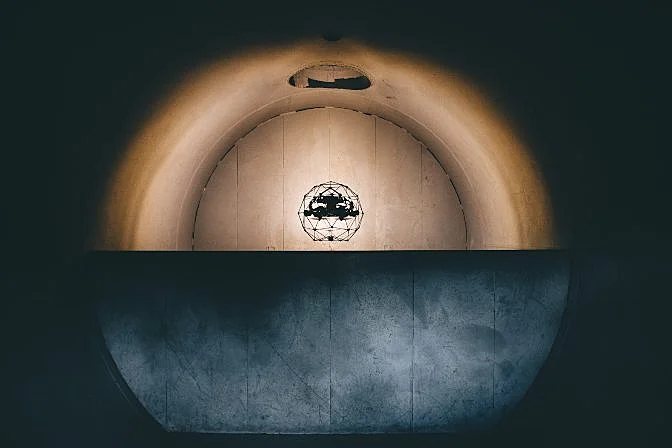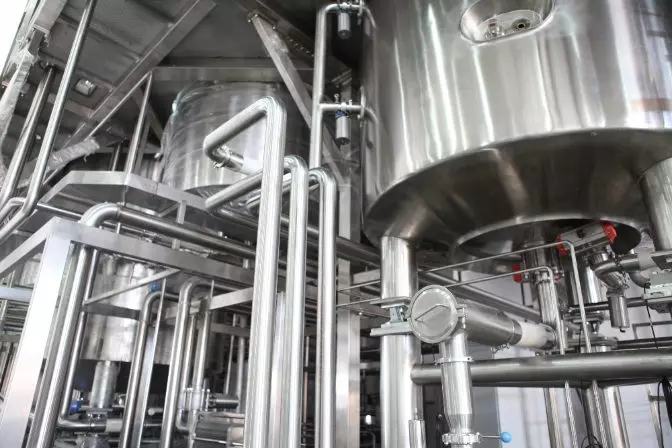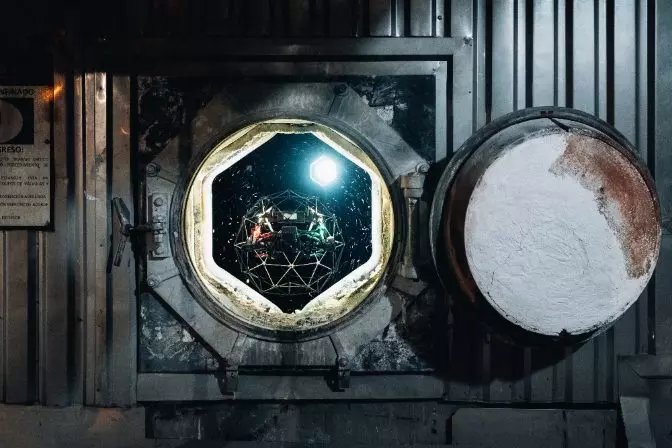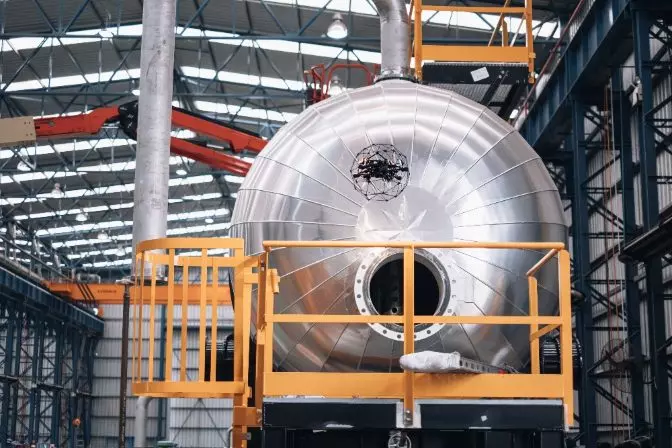What is a Pressure Vessel?
Pressure vessels are industrial containers designed to hold vapors, liquids, or gases under pressure. These vessels are essential in many industries, from energy production to chemical processing, where they help manage and control substances that could be hazardous if not properly contained.
Because pressure vessels often operate at high pressures, they can pose significant risks if not maintained correctly. Regular inspections are crucial for identifying potential issues early on, preventing costly failures and ensuring the safety of workers and the environment.
This guide provides an in-depth look at pressure vessels, covering their definition, inspection requirements, common questions, and how modern technologies like drones are revolutionizing the inspection process.
What is a Pressure Vessel?
While we briefly defined pressure vessels earlier as "containers designed to hold vapors, liquids, or gases at a specific pressure," it's important to understand that each country has its own strict regulations regarding what qualifies as a pressure vessel. This variation highlights the importance of clear definitions and standards.
The reason for these strict definitions is simple: pressure vessels can be extremely dangerous. If not built or maintained properly, they can fail catastrophically, leading to explosions, leaks, or fires that endanger lives and cause environmental damage.
To address these risks, every country has laws governing the design, construction, and operation of pressure vessels. Each vessel also has specific operating limits—known as its "design pressure and design temperature"—which must be strictly adhered to during use.

Operating a pressure vessel beyond its design parameters can lead to catastrophic failure. In extreme cases, this may result in explosions, toxic gas leaks, or fires, all of which pose serious threats to nearby personnel and infrastructure.
Common Characteristics of Pressure Vessels
Pressure vessels have several defining features that make them suitable for high-pressure environments:
- Shape. While any shape is theoretically possible, the most common forms are cylinders, spheres, and cones, which offer optimal strength and stability under pressure.
- Design. The mass of a pressure vessel is closely related to the volume it holds and the pressure it must withstand. Stronger materials allow for lighter designs, improving efficiency and reducing costs.
- Construction Materials. Steel is the most commonly used material due to its strength and durability. Other options include composites and reinforced concrete, depending on the application.
- Corrosion Resistance. In environments prone to corrosion, materials must be selected carefully to ensure long-term reliability and safety.
- Pressure Rating. Most pressure vessels are designed to operate at 15 psig or higher, making them distinct from standard storage tanks.
Note: Psig stands for Pounds Per Square Inch Gauge, a unit used to measure pressure relative to atmospheric pressure.
Types of Pressure Vessels
Pressure vessels come in various types, each suited for specific applications:
- Storage Tanks: Used for storing liquids, often made of carbon steel.
- Boilers: Designed to produce steam or hot water, typically made of alloyed steel to handle high temperatures and pressures.
- Heat Exchangers: Used in a wide range of industries to transfer heat between fluids.
- Process Vessels: Used for chemical reactions, mixing, or separation processes.
Safety Considerations in Pressure Vessel Design
Given the potential dangers, safety is a top priority in pressure vessel design. Key features include:
- Safety Valves: These release excess pressure to prevent over-pressurization.
- Leak Before Burst: A design feature that allows controlled leakage rather than sudden rupture, enhancing safety.
Pressure Vessel Inspections
Regular inspections are vital for maintaining the integrity and safety of pressure vessels. This section covers the frequency of inspections, what they involve, and the tools used to conduct them.
 The Elios 2 collects visual data during a pressure vessel inspection
The Elios 2 collects visual data during a pressure vessel inspection
Frequency of Inspections
Most regulations require pressure vessels to be inspected at least once every five years. Additional inspections are needed after installation and before the vessel is put into service.
What Is Done During an Inspection
Inspections may involve checking the exterior, interior, or both. Common tasks include:
- Visual assessments of insulation, welds, and joints.
- Thickness measurements to detect wear.
- Stress analysis to determine structural integrity.
- Testing of pressure relief valves.
- Hydrostatic pressure tests to verify performance.
Types of Pressure Vessel Testing
Five common testing methods are used during inspections:
1. Visual Testing
Inspectors visually check for cracks, corrosion, or other defects on the vessel’s surface.
2. Ultrasonic Testing
Uses sound waves to measure thickness and detect internal flaws.
3. Radiographic Testing
Uses X-rays to identify surface and subsurface defects.
4. Magnetic Particle Testing
Detects surface flaws by applying magnetic fields and ferromagnetic particles.
5. Dye Penetrant Testing
Uses a fluorescent dye to reveal surface cracks and imperfections.

Pressure Vessel Inspection Checklist
Here’s a typical checklist used during inspections:
External Inspections
- Check for defects in insulation and coatings.
- Look for signs of leakage.
- Inspect mountings for proper expansion and contraction.
- Examine the vessel for cracks, gouges, or deformations.
- Check nuts, bolts, and flanges for corrosion.
- Inspect shell surfaces and heads for bulges or blisters.
- Examine welded joints for cracks or defects.
Internal Inspections
- Check for internal cracks, corrosion, or deformation.
- Ensure threaded connections have enough engagement.
- Verify that openings are free from obstructions.
- Inspect special closures for adequacy.
- Check areas of high stress for cracks or wear.
For a printable version, copy the list above into a document and add checkboxes next to each item.
Common Questions About Pressure Vessels
Below are some frequently asked questions about pressure vessels, with detailed answers:
- At what pressure does a vessel become a pressure vessel?
- What is the difference between an unfired and a fired pressure vessel?
- What regulatory bodies oversee pressure vessel construction and inspection?
- What are the global pressure vessel standards?

At What Pressure Does a Vessel Become a Pressure Vessel?
Typically, a vessel is considered a pressure vessel if it operates at 15 psig or higher. However, this threshold can vary based on local regulations and industry standards.
What Is the Difference Between an Unfired and a Fired Pressure Vessel?
An unfired pressure vessel is not exposed to direct heat, while a fired vessel receives heat either directly or indirectly. Fired vessels require additional safety measures due to the risk of overheating.
What Regulatory Codes Apply to Pressure Vessels?
Regulatory codes vary by country but include standards such as ASME in North America, EN 13445 in Europe, and JIS in Japan.
What Are the Pressure Vessel Standards Around the World?
Some of the most widely recognized standards include ASME Section VIII, EN 13445, and API 510, among others.
Five Ways Drones Can Help with Pressure Vessel Inspections
Drones are transforming the way pressure vessel inspections are conducted. They provide a safe, efficient, and cost-effective way to collect high-quality visual data without requiring human entry into confined spaces.

Using a drone like the Elios 2, inspectors can navigate tight spaces and capture detailed images of the vessel's interior, ensuring accurate and timely assessments.
Here are five key benefits of using drones for pressure vessel inspections:
1. Safety
Drones eliminate the need for humans to enter hazardous environments, significantly improving safety during inspections.
2. Cost Savings
By reducing the need for scaffolding and minimizing downtime, drones can lower inspection costs substantially.
3. Access
Drones can reach difficult-to-access areas, providing a closer view of critical components like welds and nozzles.
 The Elios 2 inspecting a gas tank
The Elios 2 inspecting a gas tank
4. Better Data
Drones capture high-resolution images and videos, allowing for detailed documentation and historical comparisons.
5. Environmental Benefits
Increased inspection frequency enabled by drones can reduce emissions, as shown in studies by companies like Boiler Room Consulting.
Â
The Future of Pressure Vessel Inspections
The future of pressure vessel inspections is being shaped by advancements in technology. One of the most promising developments is the growing use of drones equipped with advanced sensors and imaging systems.
The Growing Adoption of Drones
Drones are becoming increasingly popular for pressure vessel inspections due to their ability to access hard-to-reach areas safely and efficiently. As more companies recognize the benefits of using drones, their adoption continues to rise across industries.
With real-time data collection and improved navigation capabilities, drones enable more frequent and comprehensive inspections, helping to prevent failures and improve overall safety.
Recent Technological Advances May Diversify Drone Use Cases
New technologies like SLAM (Simultaneous Localization and Mapping) are expanding the possibilities for drone inspections. For example, the Elios 3 can create 3D maps in real time, giving inspectors precise location data and improving defect detection accuracy.
Drones can also be equipped with specialized sensors for ultrasonic thickness testing, thermal imaging, and gas leak detection, further enhancing their utility in industrial settings.
As software improves, managing and analyzing the large volumes of data collected by drones becomes faster and more efficient, making remote inspections even more effective.
condensator and evaporator
condensator of car
Xinxiang Yukun Refrigeration Technology Co.Ltd , https://www.yukunevaporator.com
